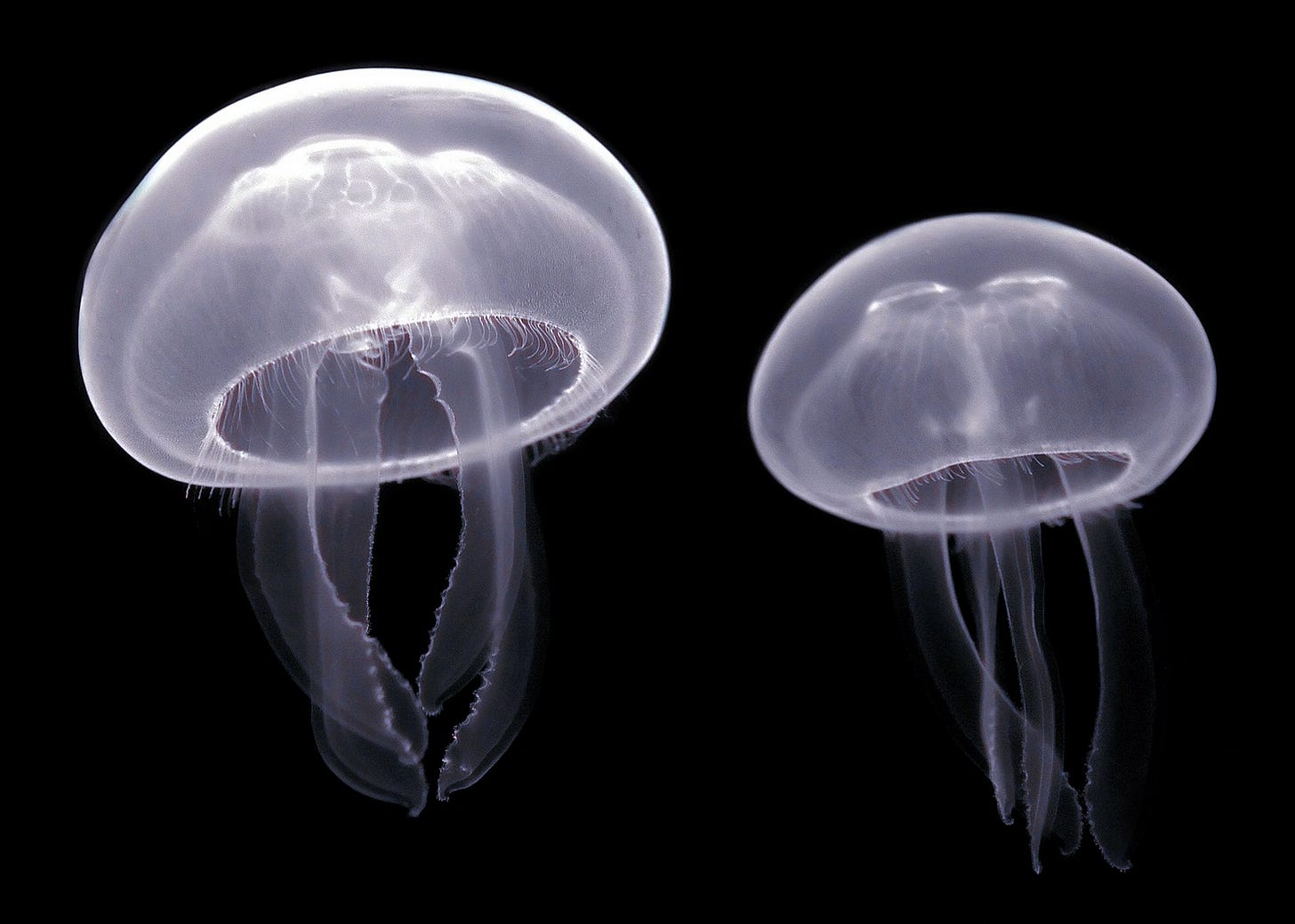One day this past spring, while I was doing historical tours of the lower East River on the NYC Ferry, as the ferry pulled in to its berth in the Brooklyn Navy Yard, young Marianna Vasquez shouted out: “Mama! Papa! Look! Stranger Things!!!” She pointed at an immense poster on the side of the Duggal Greenhouse, advertising Stranger Things: The Experience. Marianna said it was her favorite TV show, and her older siblings and her parents said they all loved the show too.
Yesterday, having crossed the East River to the Navy Yard on another warm afternoon of this glorious Indian Summer week, I biked over to the building to take a closer look, and found it empty. Stranger Things: The Experience had pulled up stakes for its next stop, in San Francisco.
The tide was low, so I poked along the shoreline, and was delighted to find the remains of a few Moon Jellyfish (Aurelia aurita) on the seaweed–covered rocks. You can find these on nearly any east coast beach, at most any time of year, the little round discs of transparent jelly with the 4–leaf–clover pattern in the center (the gonads!). Unlike Netflix extravaganzas, these ubiquitous creatures are here off our shore all–year–long, as they have been for countless millennia.
They are indeed – like all their brethren Medusae, i.e., jellyfish – strange things. 95% water, they possess no brain, heart, blood, eyes, or ears. With no lungs, gills, or trachea, they receive oxygen by diffusion through a thin membrane. Before maturing to the familiar medusa stage, they live as tiny tubular polyps that are essentially a sessile mouth. They pulse in regular rhythmic contractions that propel them through the sea’s surface waters, where they catch their zooplankton prey with poisonous sting cells on their tentacles.
Working this week on a Public Domain Review essay (where I explore other “stranger things”) about marine zoologist Alfred Goldsborough Mayer’s magisterial three–volume Medusae of the World (1910), I had come upon Mayer’s beautiful illustrations of Aurelia, and been wondering if he had ever seen the stranded Jello discs on this same shore, or out at Coney Island, in the years (1900–1905) that he lived up on Eastern Parkway, across from the Brooklyn Museum, while he had been Curator of Zoology of the new Brooklyn Museum.
During Mayer’s lifetime (1868 – 1922), the world’s biologists were nearing the culmination of a centuries–long enterprise to build up a comprehensive picture of organic life, even penetrating the mysteries of the great ocean deeps, guided by Darwin’s theory of evolution by “natural selection.” Each of Mayer’s spectacular drawings was made with the conviction that he was describing but one more branch on the great Tree of Life that culminated in the human being.
In the very same years (1900 – 1910) that A. G. Mayer was traveling the world collecting and drawing the Medusae, Rudolf Steiner often would invoke a very different image of die Qualle, or die Meduse – the German words for “jellyfish.” Describing human evolution from his clairvoyant spiritual scientific research that clearly placed the human being as the forerunner of Earth’s myriad biological forms both fossil and extant, Steiner spoke of Atlantean humanity as “formed out of a soft, pliant substance similar to a jellyfish, but much warmer.” (10/25/05 lecture) In a 1924 lecture, speaking again of colloidal, Jello–like Atlantean humanity, noting the influence of the Moon upon the evolution of the human head, he declared: “We must study the cosmic forces and constellations of the stars if we are to have any understanding of the form of a living being.” (4/23/24)
A century ago, Rudolf Steiner gave the world the foundations of a new zoology, a Magizoology; the world has yet to elaborate this exploration of “stranger things” – infinitely stranger and mysterious and magical than the Materialist science that has given rise to the proliferation of science fictions like Stranger Things. From where and when will come the Magizoology that will discover the true affinity between the Moon, the Moon Jellyfish, and Man/Woman?
Perhaps it will come from you, dear reader! And welcome (thanks to Joel and the Starlight Substack) to a veritable moon jelly swarm of new Masquerade readers – Luba, Leah, Michael, Darlene, Benny, Eileen, Ed, John, Giselle, Kathleen, Robert, and a few others whose names elude deciphering from your email addresses. Please feel free to drop me a line telling me about yourself and your interests – and what stranger things await exploration in your neighborhood.







